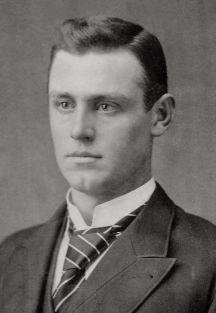|
Dr. Charles H. Albrecht (1864–1944)
Charles identified the dental remains of
Clara Reid. He was a resident of Waukegan, IL, about fifty miles
north of Chicago where he practiced
dentistry for over fifty years. Charles had
graduated from Northwestern's dental college
in Chicago. He later adopted
Anglicized spelling of
his name: Albright. Married to Mary E.
Cone Albrecht. They did not have children.

Dr. Harry Jay Combs (1871–1950)
Harry identified the body of
Elizabeth Duvall. He was married to Lillian M. Field
Combs, an artist in the print department of the Art
Institute at one time, and they had one
child, a daughter named Lorraine.
In 1943 they remodeled their century-old
home to vault the ceiling over the living
room. A relative has done much work on
the family's genealogy; the family photos
depict a happy family. Lillian loved
dogs :) Harry was the son of Amos and Virginia
Combs.
Dr. Fredrick G. Elwell (1854–1937)
Fred identified the body of
Anna Dixon.. He was married to
Louise Winter Elwell, an unusual woman of
her time in that she worked after marriage,
teaching public school in Chicago for fifty
years, serving as assistant principal at the
Gladstone School for thirty-five of those
years. They did not have children.
Dr. Victor H. Fuqua (1870–1930)
Victor made the identification that helped
unsnarl a body mix-up between two young
boys:
Howard Palmer and
Jimmy Henning.
Two weeks after the fire, Fuqua positively identified
the body of Jimmy Henning by
his teeth. The body was being held in
a vault awaiting shipping. The family of Howard Palmer
returned Jimmy's body to his family and
hired a detective to find Howard's body —
that when found was also identified by a
dentist but his name was not reported. Fuqua
was said to be a lifelong friend of Jimmie's
father, James Henning. Victor was
married to Grace D. Williams Fuqua and had
one child, a daughter named Hortense.
Dr. William A. Hoover (1861-1937)
William identified the body of Anna Hanson,
a school teacher from Gibson, Illinois who
had roomed and the Hoover household.
|
 |
Dr. David Arthur Hare (1873–1959)
 David Hare sometimes went by his middle
name, or his initials.
His daughters were young when he
passed away. As they grew older, his
wife shared stories of their father's life.
One of the stories was about David having
helped identify Iroquois Theater fire victims.
Fortunately, one of his daughters shared
that nugget. I did not find his name
in 1903/4 Chicago newspapers, but the
South Bend Tribune ran the story at
right on Monday, five days after the fire.▼2
David Hare sometimes went by his middle
name, or his initials.
His daughters were young when he
passed away. As they grew older, his
wife shared stories of their father's life.
One of the stories was about David having
helped identify Iroquois Theater fire victims.
Fortunately, one of his daughters shared
that nugget. I did not find his name
in 1903/4 Chicago newspapers, but the
South Bend Tribune ran the story at
right on Monday, five days after the fire.▼2
The Trib story doesn't reference dental identification
but contains two useful bits of unrelated information.
The first is that some of the morgues were so
overly full of bodies▼3 that they
had to lay them out in attics and furnace
rooms.
This is useful in better
understanding why the morgues needed to close the
morgues at midnight the night of the fire to
organize bodies. (Which is why Hare
had such a difficult time gaining entrance.) Routing streams of
morgue visitors up and down stairwells was a
serious logistics problem.
Hare's remarks
also support the inaccuracy of
out-of-Chicago newspapers who exaggerated
the number of victims found dead in their
seats to suggest that there were hundreds —
a titillating blame-the-victim scene worthy of a contemporary
horror film.
Hare's quote from Police Dept Secretary,
Simon Si Mayer, corroborates the observations
of fireman
Michael Roche that only a
handful of people met their fate while
sitting calmly in their seats at the
Iroquois.
|
